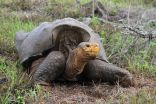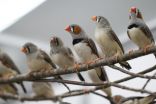Giant tortoises gain a foothold on a Galapagos Island
Endemic species establishes secure population; ecosystem needs further repair
2014-10-28
(Press-News.org) A population of endangered giant tortoises, which once dwindled to just over a dozen, has recovered on the Galapagos island of Española, a finding described as "a true story of success and hope in conservation" by the lead author of a study published today (Oct. 28).
Some 40 years after the first captive-bred tortoises were reintroduced to the island by the Galapagos National Park Service, the endemic Española giant tortoises are reproducing and restoring some of the ecological damage caused by feral goats that were brought to the island in the late 19th century.
"The global population was down to just 15 tortoises by the 1960s. Now there are some 1,000 tortoises breeding on their own. The population is secure. It's a rare example of how biologists and managers can collaborate to recover a species from the brink of extinction, " said James P. Gibbs, a professor of vertebrate conservation biology at the SUNY College of Environmental Science and Forestry (ESF) and lead author of the paper published in the journal PLOS ONE.
Gibbs and his collaborators assessed the tortoise population using 40 years of data from tortoises marked and recaptured repeatedly for measurement and monitoring by members of the Galapagos National Park Service, Charles Darwin Foundation, and visiting scientists.
But there is another side to the success story: while the tortoise population is stable, it is not likely to increase until more of the landscape recovers from the damage inflicted by the now-eradicated goats.
"Population restoration is one thing but ecological restoration is going to take a lot longer," he said.
After the goats devoured all the grassy vegetation and were subsequently removed from the island, more shrubs and small trees have grown on Española. This hinders both the growth of cactus, which is a vital piece of a tortoise's diet, and the tortoises' movement. Chemical analysis of the soil, done by Dr. Mark Teece, an ESF chemistry professor, shows there has been a pronounced shift from grasses to woody plants on the island in the last 100 years.
The shrubs and trees also inhibit the movements of the endangered waved albatross that breeds on the island. Gibbs said the plants make it difficult for the ungainly sea birds to take flight.
"This is a miraculous conservation success accomplished by the Galapagos National Park Service," said Gibbs, " but there is yet more work to fully recover the ecosystem upon which the tortoises and other rare species depend."
INFORMATION:
Gibbs' co-authors on the study are Elizabeth A. Hunter, an ESF alumna who is now a Ph.D. student at the University of Georgia; Kevin T. Shoemaker, an ESF alumnus who is now a research scientist at SUNY's Stony Brook University; Washington H. Tapia formerly of the Galapagos National Park Service; and Linda J. Cayot of the Galapagos Conservancy. The research was supported by the Galapagos National Park Service, the Galapagos Conservancy, the Prometeo Program of Ecuador's National Secretariat for Higher Education, Science, Technology and Innovation, and the U.S. National Science Foundation.
The publication will be available online Oct. 28 at http://dx.plos.org/10.1371/journal.pone.0110742.
[Attachments] See images for this press release:

ELSE PRESS RELEASES FROM THIS DATE:
2014-10-28
New Haven, CT, Oct. 28 2014 – Each year, malaria kills over 600,000 people, more than half of them children. In a study published today in PLOS ONE , researchers with the non-profit Innovations for Poverty Action (IPA) and Harvard University found that simple text message reminders to take malaria medication can help in the fight against the disease by boosting the rates at which patients complete their medication regimen.
One challenge in fighting malaria is that the disease has evolved resistance to many drugs that formerly worked, according to Julia Raifman, ...
2014-10-28
This news release is available in German.
In addition to their song, songbirds also have an extensive repertoire of calls. While the species-specific song must be learned as a young bird, most calls are, as in the case of all other birds, innate. Researchers at the Max Planck Institute in Seewiesen have now discovered that in zebra finches the song control system in the brain is also active during simple communication calls. This relationship between unlearned calls and an area of the brain responsible for learned vocalisations is important for understanding the ...
2014-10-28
JUPITER, FL, October 28, 2014 – Scientists from the Florida campus of The Scripps Research Institute (TSRI) have uncovered a major contributor to Huntington's disease, a devastating progressive neurological condition that produces involuntary movements, emotional disturbance and cognitive impairment.
Using an animal model of Huntington's disease, the new study shows that signaling by a specific protein can trigger onset of the disease and lead to exacerbation of symptoms. These findings, published in the October 28, 2014 issue of the journal Science Signaling, offer ...
2014-10-28
A connection between inflammation and cancer has been recognized for over a hundred years. This connection is particularly evident in colon carcinogenesis, because patients with IBD have a higher incidence of colon cancer than the general population. There is increasing evidence that inflammation contributes to the earliest stages of carcinogenesis, namely in the process of cell transformation, where the cell acquires many aspects of cancer characteristics. The observation that IBD and colon cancer incidence rise as nations industrialize suggests that changes in diet and ...
2014-10-28
PROVIDENCE, R.I. [Brown University] — New research by physicists from Brown University puts the profound strangeness of quantum mechanics in a nutshell — or, more accurately, in a helium bubble.
Experiments led by Humphrey Maris, professor of physics at Brown, suggest that the quantum state of an electron — the electron's wave function — can be shattered into pieces and those pieces can be trapped in tiny bubbles of liquid helium. To be clear, the researchers are not saying that the electron can be broken apart. Electrons are elementary particles, ...
2014-10-28
Politics can have unintentional evolutionary consequences that may cause hastily issued policies to cascade into global, multigenerational problems, according to political scientists.
"Most western democracies look at policies as if they are bandages, we fix what we can and then move on," said Pete Hatemi, associate professor of political science, Penn State. "But we need to consider generational policies so that we can fix what we can now, but also be prepared for what comes next."
The researchers said that there is an interaction between political and cultural forces ...
2014-10-28
WASHINGTON, D.C., October 28, 2014 – In the future, computers may be capable of talking to us during meetings just like a remote teleconference participant. But to help move this science-fiction-sounding goal a step closer to reality, it's first necessary to teach computers to recognize not only the words we use but also the myriad meanings, subtleties and attitudes they can convey.
During the 168th Meeting of the Acoustical Society of America (ASA), to be held October 27-31, 2014, at the Indianapolis Marriott Downtown Hotel, Valerie Freeman, a Ph.D. candidate in ...
2014-10-28
One of the tragic realities of cancer is that the drugs used to treat it are highly toxic and their effectiveness varies unpredictably from patient to patient. However, a new "tumor-in-a-dish" technology is poised to change this reality by rapidly assessing how effective specific anti-cancer cocktails will be on an individual's cancer before chemotherapy begins.
A team of biomedical engineers at Vanderbilt University headed by Assistant Professor Melissa Skala has developed the technique, which uses fluorescence imaging to monitor the response of three-dimensional chunks ...
2014-10-28
Tropical Cyclone Nilofar developed an eye on Oct. 28 that seemed to stare at NASA's Terra satellite as it passed overhead in space. Warnings are already in effect from the India Meteorological Department as Nilofar is forecast to make landfall in northwestern India.
On Oct. 28 at 06:50 UTC (2:50 a.m. EDT) the MODIS instrument aboard Terra captured a visible image of Tropical Cyclone Nilofar after it developed an eye while moving north in the Arabian Sea. The 12 nautical mile (13.8 miles/22.2 km) wide eye was surrounded by powerful thunderstorms and bands of thunderstorms ...
2014-10-28
DEET has been the gold standard of insect repellents for more than six decades, and now researchers led by a University of California, Davis, scientist have discovered the exact odorant receptor that repels them.
They also have identified a plant defensive compound that might mimic DEET, a discovery that could pave the way for better and more affordable insect repellents. Findings from the study appear in the journal Proceedings of the National Academy of Sciences.
More than 200 million people worldwide use DEET, developed by scientists at the U.S. Department of Agriculture ...
LAST 30 PRESS RELEASES:
[Press-News.org] Giant tortoises gain a foothold on a Galapagos Island
Endemic species establishes secure population; ecosystem needs further repair




